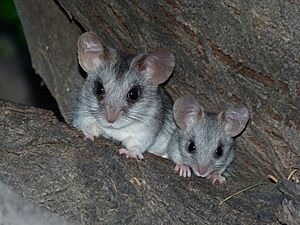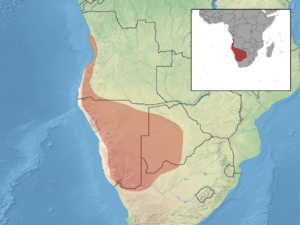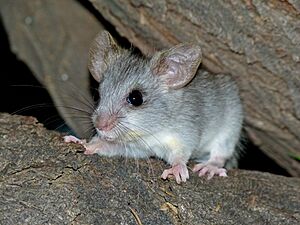Black-tailed tree rat facts for kids
Quick facts for kids Black-tailed tree rat |
|
|---|---|
 |
|
| Adult with young | |
| Conservation status | |
| Scientific classification | |
| Genus: |
Thallomys
|
| Species: |
nigricauda
|
 |
|
| Synonyms | |
|
|
The black-tailed tree rat, also known as the black-tailed acacia rat, is a small rodent that lives in trees. Its scientific name is Thallomys nigricauda. You can find these rats in parts of Angola, Botswana, Namibia, and South Africa. They prefer dry areas with lots of shrubland. These rats are active at night (nocturnal) and live in trees (arboreal). They build big nests, often in acacia trees, and eat leaves and buds.
Contents
About the Black-tailed Tree Rat
What Does It Look Like?
The black-tailed tree rat is a medium-sized rodent. Its head and body are about 13.5 centimeters (5.3 inches) long. Its tail is a bit longer, around 14.5 centimeters (5.7 inches). The sides of its face are grey. A dark stripe runs from its nose, around its large eyes, and under its ears. It has long whiskers. Its ears are big and oval-shaped.
The fur on its back is long and soft, a grey color with a hint of yellow. Its belly is white. Its legs are grey, and the tops of its wide feet are white. The long tail is covered in black scales and black bristles. It also has a tip of black hairs.
Where Do They Live?
The black-tailed tree rat lives only in southwestern Africa. Its home range includes southwestern Angola, Namibia, Botswana, and northwestern South Africa. It lives in dry savanna areas. It also likes thorny scrubland with thick patches of trees. These trees can include Vachellia erioloba, Vachellia luederitzii, Vachellia karroo, Euclea pseudebenus, Terminalia sericea, and Boscia albitrunca.
Life in the Trees
This rat spends its life in trees and is active at night. Its wide feet and strong claws help it climb very well. It uses its tail for balance. It can also use its tail to grab things, like a fifth limb.
Building a Home
Black-tailed tree rats especially like Vachellia erioloba trees. These trees have cracks and holes that are perfect for their nests. They also build nests in tree branches or under loose bark. Sometimes, one tree can have several nests, but not all of them will be in use.
The nest is large and made of grass, leaves, and twigs. It can be as deep as 30 centimeters (12 inches). The nesting material often spills out of the hole. These nests look a bit like those made by the red-billed buffalo weaver, but they use finer materials.
Family Life and Food
Sometimes, these rats live alone. Other times, a parent and several young rats live together. Both male and female rats have their own areas where they live (home ranges). Male rats usually have much larger home ranges than females.
A pair of rats and their young might share a nest. At sunset, they leave the nest to climb into the tree branches. They nibble on young Acacia shoots. They might also cross into other large trees like leadwood and mopane to find food.
Their main diet is leaves and buds. They also eat the outer parts of Acacia seed pods. Sometimes, they eat insects. They also enjoy the gum that oozes from tree branches. The rats make grooves in the bark to get this gum. They are most active in the first few hours of the night and again before dawn. They look for food high up in the trees where few other rodents go. They rarely come down to the ground. They don't need to drink water because they get enough moisture from their food.
Conservation Status
The black-tailed tree rat is a common animal. It lives in a wide area and is thought to have a large total population. It is not facing any special dangers right now. Because of this, the International Union for Conservation of Nature says its conservation status is "least concern". This means they are not worried about it becoming endangered soon.



